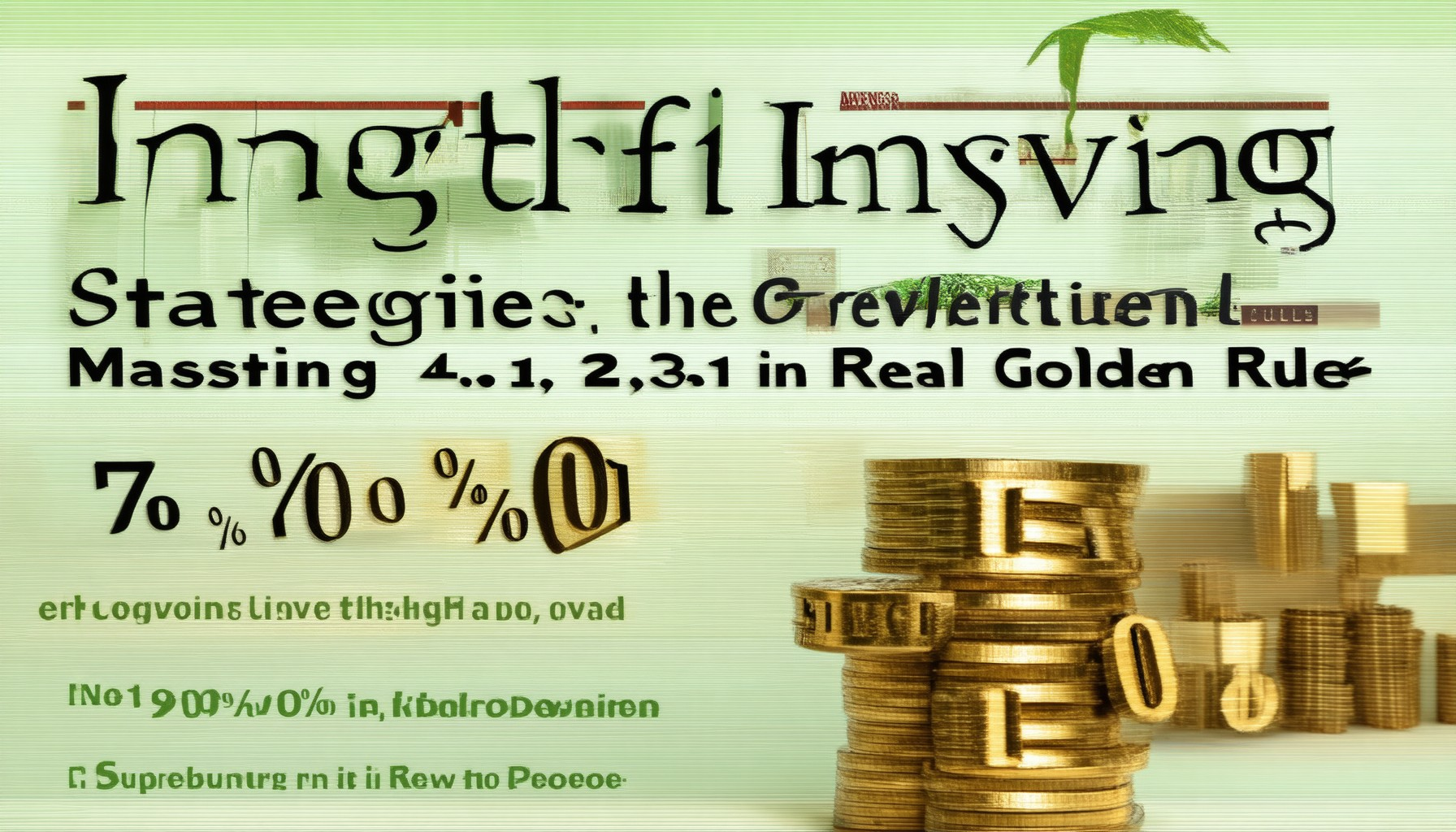Investing in real estate can be a lucrative venture, but achieving success requires a solid understanding of effective strategies and principles. From the 7% rule to the 50% rule, rental property insights, and the golden rule of real estate investing, there are numerous guidelines that can help maximize returns while minimizing risks. Whether you’re looking to buy an investment property or refine your current approach, mastering these strategies can make a significant difference in your journey toward building wealth through real estate. This article delves into the key principles that every investor should know, providing actionable insights and practical advice for those aiming to excel in the world of investment properties.
Key Takeaways
– The 4-3-2-1 Rule Provides a Structured Approach to Evaluating Property Prices: This method uses four, three, two, and one comparable properties to determine market value, offering an accurate pricing framework for sellers and buyers.
– Understanding the 80% Rule Is Essential for Informed Decisions: This rule impacts property valuation, financing, and investment strategies, affecting everything from loan approvals to rental property assessments.
– The Golden Rule Emphasizes Risk Minimization Through a 20% Down Payment: By ensuring this down payment and maintaining sufficient rental income to cover expenses, investors can achieve financial security and long-term profitability.
– Leverage Additional Resources for Expert Insights: Explore tips on real estate investment strategies and property evaluation to enhance your decision-making process.

The 7% Rule in Real Estate
The 7% rule is a fundamental guideline used by real estate investors to determine the maximum allowable profit on a property sale before accounting for taxes. This rule helps investors assess whether a property is a viable investment based on its potential profitability and tax implications.
Overview of the 7% Rule
The 7% rule states that a property can be sold for up to 107% of its cost basis (the original purchase price plus improvements) without incurring additional capital gains taxes. Here’s a breakdown of the key components:
- Cost Basis: The total amount paid for the property, including any renovations or improvements made to increase its value.
- Maximum Selling Price: 107% of the cost basis, allowing for a 7% profit margin.
- Tax Implications: Profits exceeding the cost basis are subject to capital gains taxes, which vary by jurisdiction but typically range between 0% and 33.99%
How to Apply the 7% Rule
To determine if a property meets the 7% rule, use the following formula:
Maximum Allowable Selling Price = Cost Basis × 1.07
Example:
If you purchased a property for $100,000, the maximum selling price would be $107,000 under the 7% rule. This ensures a 7% profit ($7,000) without triggering additional taxes.
Considerations
While the 7% rule is a useful tool, it has some limitations:
- Location Matters: The rule may vary depending on local tax laws and regulations.
- Improvements: The cost basis includes any upgrades made to the property.
- Timeframe: The rule applies to short-term sales (typically less than two years), as long-term gains may qualify for lower tax rates.
Practical Application Tips
For optimal success, consider these tips when applying the 7% rule:
- Assess Property Value: Ensure the property’s appraised value aligns with the 107% threshold.
- Plan for Taxes: Factor in potential tax obligations when pricing your property for sale.
- Consult Professionals: Work with a tax advisor or financial planner to navigate complex tax scenarios.
By understanding and effectively applying the 7% rule, real estate investors can make informed decisions that align with their financial goals and risk tolerance.
What is the 50% Rule in Rental Property?
The 50% rule, also known as the 50/50 rule, is a fundamental guideline used by real estate investors to evaluate the profitability of rental properties. Here’s a breakdown of the rule and how it applies:
Definition of the 50% Rule
The 50% rule states that no more than 50% of the gross rental income generated by a property should be allocated to operating expenses. This includes costs like utilities, maintenance, taxes, insurance, and management fees. The remaining 50% should be considered as profit.
Why the 50% Rule Matters
This rule is crucial for investors because it helps prevent overestimation of profits and underestimation of expenses. By ensuring that at least half of the income is reserved for expenses, investors can make more informed decisions about whether a property is generating a viable return.
How to Apply the 50% Rule
To implement the 50% rule: 1. Calculate the total monthly rental income. 2. Determine all operating expenses, including utilities, taxes, insurance, and maintenance. 3. Ensure that operating expenses do not exceed 50% of the gross rental income. 4. If expenses exceed 50%, consider increasing the rent or evaluating the property’s potential.
Example Scenario
Suppose a rental property generates $2,000 in gross monthly rental income. According to the 50% rule: – Maximum allowable operating expenses = $1,000. – Profit = $1,000.
If actual expenses are $1,200, the property does not meet the 50% rule, indicating it may not be a profitable investment.
Considerations
- The 50% rule is a general guideline and may vary based on property type, location, and market conditions.
- Investors should always consult with a financial advisor or tax professional to tailor their approach to individual circumstances.
By adhering to the 50% rule, investors can make more informed decisions about their rental properties and achieve long-term success in real estate investing.

What is the 2% Rule for Investment Property?
The 2% rule is a commonly referenced guideline in real estate investing. It suggests that a rental property is considered a desirable investment if the annual rent collected from tenants is at least 2% of the property’s purchase price. This rule helps determine whether a property is generating sufficient income to be financially viable.
How the 2% Rule Works
To calculate whether a property meets the 2% rule, divide the annual rent by the purchase price of the property. If the result is 2% or higher, the property may qualify as a strong investment candidate. For example:
- If a property costs $200,000 and generates $4,000 annually in rent, the 2% rule is met because 4000 ÷ 200,000 = 0.02 or 2%.
Key Factors Influencing the 2% Rule
Several factors can impact whether the 2% rule applies effectively:
- Property Location: Properties in high-demand areas may command higher rents, making the 2% rule easier to meet.
- Rental Demand: Strong demand for rental units can drive higher rents and improve profitability.
- Property Condition: Well-maintained properties may attract higher-paying tenants.
- Management Costs: Higher management fees can reduce the effective return on investment.
Considerations Before Applying the 2% Rule
While the 2% rule offers a useful framework, it’s important to evaluate other aspects of a property’s potential:
- Long-Term Appreciation: Properties often appreciate over time, potentially increasing equity.
- Financing Terms: Interest rates and loan structures can significantly impact overall returns.
- Tax Implications: Rental properties may offer tax benefits that enhance net returns.
Example Scenarios
Understanding the 2% rule through real-world examples can clarify its application:
- A $300,000 property renting for $6,000 monthly meets the 2% rule (6000 ÷ 300,000 = 2%).
- A $500,000 property renting for $10,000 monthly exceeds the 2% threshold (10000 ÷ 500,000 = 2%).
By evaluating these factors and examples, investors can better determine if a property aligns with their financial goals and risk tolerance. The 2% rule serves as a helpful starting point, but it’s essential to consider other variables for a comprehensive assessment.

The 4-3-2-1 Rule in Real Estate
The 4-3-2-1 rule is a commonly used method in real estate appraisals and pricing to determine the market value of a property. Here’s a breakdown of how it works:
- 4: This represents the highest comparable property in the area. It serves as the benchmark for determining the market value.
- 3: The second-highest comparable property, which is slightly less expensive than the first one.
- 2: The third-highest comparable property, which is further below the market rate.
- 1: The lowest comparable property, typically the least expensive among the selected ones.
This method helps appraisers and sellers establish a fair price estimate by comparing similar properties in the local market. The 4-3-2-1 rule is widely used to ensure accuracy in pricing decisions, helping sellers set realistic expectations and buyers make informed offers.
What is the 80% Rule in Real Estate?
The 80% rule in real estate is often referenced in various contexts, including property valuation, insurance, and lending decisions. Here’s a breakdown of its common applications:
- Property Valuation: In some cases, the 80% rule is used to estimate a property’s market value. Lenders may use this method to determine loan amounts based on the property’s assessed value.
- Insurance Coverage: Homeowners insurance policies often cover 80% of the property’s replacement cost. This means policyholders are responsible for covering the remaining 20%, which is typically their own obligation.
- Mortgage Approvals: Some lenders use the 80% rule to set loan-to-value ratios. A buyer can secure a mortgage for up to 80% of the property’s purchase price, with the remaining 20% serving as a down payment.
- Investment Decisions: Real estate investors may use the 80% rule to evaluate potential properties. They aim to purchase properties at 80% of their estimated rental income potential to ensure profitability.
Understanding the 80% rule can be crucial for buyers, sellers, and investors alike. It helps in making informed decisions regarding property values, financing options, and risk management.

The Golden Rule of Real Estate Investing
The golden rule of real estate investing centers around two primary principles:
- Putting at least 20% down payment on the property to minimize risk and maximize leverage.
- Ensuring that the rent collected from tenants covers the mortgage payments and other associated costs.
To enhance the profitability and sustainability of your investment, consider the following:
- Down Payment Strategy: A 20% down payment demonstrates financial commitment and reduces your risk exposure. This allows you to secure financing with favorable terms and builds equity over time.
- Rental Property Selection: Prioritize properties with strong rental demand and potential for appreciation. Evaluating market conditions and local regulations is crucial before finalizing your purchase.
- Mortgage Coverage: Aim to have the rent cover not just the principal and interest but also property taxes, insurance, and maintenance costs. This ensures steady cash flow and long-term profitability.
Adhering to the golden rule offers several advantages:
- Financial Security: With a robust down payment and stable rental income, you reduce your financial risk and ensure consistent cash flow.
- By securing a property with capable tenants, you can enjoy monthly rent that covers your obligations, creating a hands-off investment strategy.
- Real estate often appreciates over time, increasing your asset value and overall returns.
By following the golden rule and thoughtfully managing your investment, you can build a resilient and lucrative real estate portfolio. Remember to evaluate market trends, understand local laws, and work with experienced professionals to navigate the complexities of real estate investing.
For more insights, explore our resources on Real Estate Investment Tips and Evaluating Rental Properties .




0 Comments